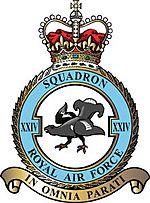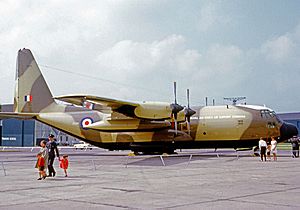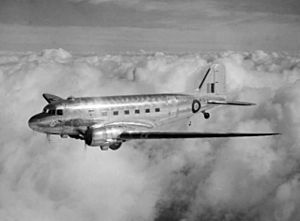No. 24 Squadron RAF facts for kids
Quick facts for kids No. XXIV Squadron RAF |
|
|---|---|

Squadron badge
|
|
| Active | 21 September 1915 – present |
| Country | |
| Branch | |
| Type | Operational Conversion Unit |
| Role | Air mobility fleet training |
| Part of | No. 2 Group RAF |
| Home station | RAF Brize Norton |
| Nickname(s) | Commonwealth |
| Motto(s) | In omnia parati (Latin for 'Prepared for all things' / 'Ready for anything') |
| Aircraft |
|
| Battle honours |
|
| Commanders | |
| Current commander |
Wing Commander G Anderson |
| Notable commanders |
Major L G Hawker |
| Insignia | |
| Squadron badge heraldry | A blackcock, selected because of its speed and strength on the wing, the cock is in fighting attitude to suggest the squadron’s ability to turn itself into a war fighting unit at short notice, despite a peacetime training role. Approved by HM King George VI in June 1937. |
No. 24 Squadron, also called No. XXIV Squadron, is a special part of the Royal Air Force. It is known as the Air Mobility Operational Conversion Unit (AMOCU). The squadron is based at RAF Brize Norton in Oxfordshire, England.
Its main job is to train aircrews to fly large transport planes. These planes include the C-130J Hercules, the A400M Atlas, and the C17 Globemaster. No. 24 Squadron also trains engineers to fix and maintain these aircraft.
Contents
Squadron History
Early Days as a Fighter Squadron (1915–1919)
No. 24 Squadron started on 1 September 1915. It was part of the Royal Flying Corps back then. The squadron first used D.H.2 fighter planes in France in February 1916. These planes were known for spinning easily. However, their leader, Major Lanoe Hawker, taught pilots how to recover from a spin. This helped pilots learn to love how easy the planes were to fly.
By early 1917, the D.H.2 planes were getting old. They were replaced by the Airco DH.5. These new planes were not great for air combat. So, the squadron used them to attack targets on the ground instead. They helped in battles like the Battle of Messines and the Battle of Cambrai.
Later, in December 1917, the squadron received SE.5a planes. After a few months of ground attacks, they went back to fighting in the air. By October 1918, the squadron had shot down 200 enemy aircraft. After World War I ended, the squadron returned to England and was closed down in February 1919.
VIP Transport Squadron (1920–1968)
The squadron started up again on 1 February 1920. It was based at RAF Kenley. This time, its job was to carry messages and train pilots. During the General Strike of 1926, the squadron delivered government messages. This was because normal mail services were not working.
When Second World War began, the squadron started using civilian airliners. These planes were taken for wartime use. They flew important messages to France. When British troops had to leave France, the squadron helped fly them back to England. They also flew to places like Gibraltar and Malta.
No. 24 Squadron grew very big. It had routes all over the United Kingdom and even to India. It also flew important people, including Sir Winston Churchill. Because it was so large, the squadron was split up. In October 1942, the internal flights became 510 Squadron. In June 1943, another part became No. 512 Squadron. This left No. 24 Squadron to focus on long-distance flights using Avro York planes.

In February 1946, the squadron moved from RAF Hendon. The airfield there was too small for their larger planes. No. 24 Squadron also became a Commonwealth squadron. This meant that aircrews from different Commonwealth countries joined the squadron.
Transport Command Squadron (1968–2013)
In 1968, the squadron moved to RAF Lyneham. Here, they started using the Lockheed Hercules aircraft. In 2002, they got newer versions of the Hercules, called the C.4 and C.5. In 2008, the squadron celebrated 40 years of flying Hercules planes. They stayed at Lyneham until 2011, when they moved to RAF Brize Norton.
Training Squadron (2013–Present)
In 2013, No. 24 Squadron changed its role. It stopped being a front-line Hercules squadron. Instead, it became the Air Mobility Operational Conversion Unit. This means it now focuses on training. Most of the flying and engineer training for the Air Mobility Force is done here.
Today, No. 24 Squadron trains aircrews for the C130J Hercules and A400M Atlas aircraft. Its Maintenance Training School also trains engineers. These engineers learn to maintain the C130J Hercules, A400M Atlas, and C17 Globemaster aircraft. The squadron is a professional training body. It also helps train new instructors for the Air Mobility Force.
Aircraft Used by the Squadron
Over the years, No. 24 Squadron has flown many different types of aircraft. Here are some of the most important ones:
- 1916–1917 Airco DH.2
- 1917–1918 Airco DH.5
- 1917–1919 Royal Aircraft Factory SE.5A
- 1920–1930 Bristol F.2 Fighter
- 1933–1944 de Havilland Dragon Rapide and Dominie
- 1939–1942 Lockheed 10 Electra
- 1943–1952 Douglas Dakota
- 1943–1944 Avro York I
- 1946–1951 Avro York C1
- 1951–1968 Handley Page Hastings C2 and C4
- 1968–2000 Lockheed Hercules C130K
- 2000–present Lockheed Hercules C130J
- 2013-present Airbus A400M Atlas
Squadron Commanders
Many officers have led No. 24 Squadron since it began. Here are some of them:
- 1 September 1915, Captain A G Moore
- 29 September 1915, Major L G Hawker
- 1 April 1920, Squadron Leader E H Johnston
- June 1939, Wing Commander J Anderson
- April 1941, Wing Commander H G Lee
- October 1945, Wing Commander E L A Walter
- March 1950, Wing Commander C F Read (from the RAAF)
- January 1968, Wing Commander J E H Tetley
- August 2000, Squadron Leader G C Cook
- December 2012 Wing Commander D James
- October 2019 Wing Commander A McIntyre
See also
- List of RAF squadrons



